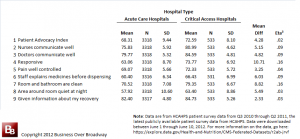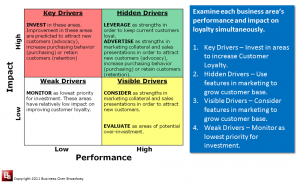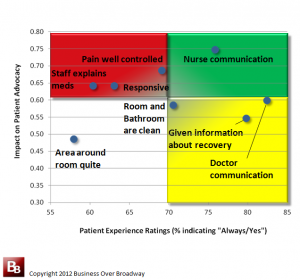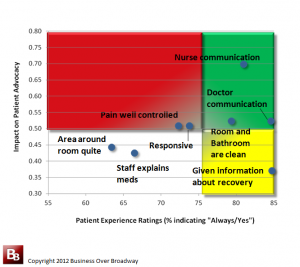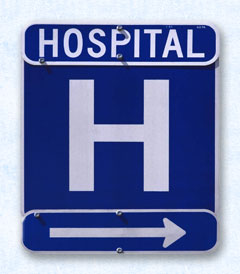
Hospitals are focusing on improving the patient experience as well as clinical outcomes measures. The Centers for Medicare & Medicaid Services (CMS) will be using patient feedback about their care as part of their reimbursement plan for Acute Care Hospitals. Under the Hospital Value-Based Purchasing Program (beginning in FY 2013 for discharges occuring on or after October 1, 2012), CMS will make value-based incentive payments to acute care hospitals, based either on how well the hospitals perform on certain quality measures or how much the hospitals’ performance improves on certain quality measures from their performance during a baseline period. The higher the score/greater the improvement, the higher the hospital’s incentive payment for that fiscal year.
Hospital Consumer Assessment of Healthcare Providers and Systems (HCAHPS)
The patients’ feedback will be collected by a survey known as HCAHPS (Hospital Consumer Assessment of Healthcare Providers and Systems). HCAHPS (pronounced “H-caps“) is a national, standardized survey of hospital patients and was developed by a partnership of public and private organizations.
The development of HCAHPS was funded by the Federal government, specifically the Centers for Medicare & Medicaid Services (CMS) and the Agency for Healthcare Research and Quality (AHRQ). HCAHPS was created to publicly report the patient’s perspective of hospital care.
The survey asks a random sample of recently discharged patients about important aspects of their hospital experience. The data set includes patient survey results for over 3800 US hospitals on ten measures of patients’ perspectives of care. The 10 measures are:
- Nurses communicate well
- Doctors communicate well
- Received help as soon as they wanted (Responsive)
- Pain well controlled
- Staff explain medicines before giving to patients
- Room and bathroom are clean
- Area around room is quiet at night
- Given information about what to do during recovery at home
- Overall hospital rating
- Recommend hospital to friends and family (Recommend)
For questions 1 through 7, respondents were asked to provide frequency ratings about the occurrence of each attribute (Never, Sometimes, Usually, Always). For question 8, respondents were provided a Y/N option. For question 9, respondents were asked to provide an overall rating of the hospital on a scale from 0 (Worst hospital possible) to 10 (Best hospital possible). For question 10, respondents were asked to provide their likelihood of recommending the hospital (Definitely no, Probably no, Probably yes, Definitely yes). For the current analysis, I created a patient loyalty metric by averaging questions 9 (Overall hospital quality rating) and 10 (Recommend hospital). In my prior analysis, this Patient Advocacy Index (PAI) had a reliability estimate (Cronbach’s alpha) of .95.
The HCAHPS data set is available to anybody who wants to download it. This data set contains a variety of metrics (patient feedback, health outcome measures, safety measures) for over 4800 US hospitals. I will focus on the patient experience metrics. Top box scores are used as the metric of patient experience. Top box scores for the respective rating scales are defined as: 1) Percent of patients who reported “Always”; 2) Percent of patients who reported “Yes”; 3) Percent of patients who gave a rating of 9 or 10; 4) Percent of patients who said “Definitely yes.” Top box scores provide an easy-to-understand way of communicating the survey results for different types of scales. Even though there are four different rating scales for the survey questions, using a top box reporting method puts all metrics on the same numeric scale. Across all 10 metrics, hospital scores can range from 0 (bad) to 100 (good).
Based on HCAHPS reporting schedule, it appears the current survey data were collected from Q3 2010 through Q2 2011 and represent the latest publicly available patient survey data.
Comparing Acute Care Hospitals and Critical Access Hospitals
The HCAHPS survey is administered to two types of hospitals, acute care and critical access. Acute Care Hospitals (ACH) are hospitals that provide short-term patient care. For Medicare payment purposes, they are generally defined as having an average inpatient length of stay greater than 25 days. Critical Access Hospitals (CAH) are small facilities that give limited outpatient and inpatient hospital services to people in rural areas that receive cost-based reimbursement.
Results
I first looked at the mean differences across the two hospital types. The descriptive statistics for each type of hospitals are located in Table 1.
- Critical Access Hospitals receive higher patient ratings on all of the metrics compared to Acute Care Hospitals. The differences between the two groups are statistically significant and are substantial; the largest differences between the two hospital types was for “Responsive” and “Room and bathroom are clean.”
Acute Care Hospitals and Critical Access Hospitals have much room for improvement in delivering a better patient experience (average top-box scores for patient experience metrics are 70 and 76, respectively). Improving the patient experience will necessarily have a positive impact on patient advocacy/loyalty toward the hospital. Determining the patient experience areas to improve is a function of their importance in driving patient advocacy; some patient experience areas are more important than others. Next, I conducted loyalty driver analysis for each hospital type.
Loyalty Driver Analysis is a business intelligence solution that helps companies understand and improve customer loyalty, an indicator of future business growth. In loyalty driver analysis, we look at two key pieces of information of each business area: 1) Performance of the business area and 2) Impact of that business area on patient loyalty. The results are typically presented in a driver matrix (see Figure 1).
The driver matrices using the patient survey data appear in Figures 2 (Acute Care) and 3 (Critical Access). We see that there are clear differences between these two driver matrices.
- The patient experience is more important for driving patient advocacy for acute care hospitals compared to critical access hospitals. For acute care hospitals, the average correlation of patient experience metrics with patient advocacy is .62. For critical access hospitals, the average correlation of patient experience metrics with patient advocacy is .50.
- Key drivers for each type of hospital are different. For acute care hospitals, three key drivers of patient advocacy are: 1) Staff explains meds, 2) Responsiveness and 3) Pain well controlled. For critical access hospitals, we see a very different picture. Only two patient experience attributes appear to be key drivers of patient advocacy: 1) Pain well controlled and 2) Responsiveness. Also, for critical access hospitals, the importance of these two areas (e.g., pain well controlled and responsiveness) are less important to patient advocacy (r = .51) compared to acute care hospitals (r = .67). These areas appear in the upper left quadrant and suggest that these areas are important to patient advocacy and have much room for improvement
- For both hospital types, the biggest driver of patient advocacy is the patients’ perception of the quality of nurses’ communication effectiveness. Because nurses are likely involved with most of the day-to-day dealings with patient care, their performance impacts many different facets of the patient experience (e.g., Responsiveness, staff explains med).
Summary and Conclusions
There are a few important points we can conclude based on the analyses.
- Acute Care Hospitals (ACH) receive lower patient experience ratings compared to Critical Access Hospitals (CAHs) across all patient experience metrics. Also, ACHs receive lower patient loyalty/advocacy ratings compared to CAHs. Identifying the causes for these differences across hospital types might shed light on how ACHs can improve/explain their lower patient experience ratings.
- While the patient experience is related to patient loyalty/advocacy across both hospital types, it appears that patient loyalty/advocacy is more closely associated with the patient experience for ACHs than for CAHs.
- The key areas for improving patient loyalty/advocacy differ across hospital types. ACHs need to focus on 1) Staff explains meds, 2) Responsiveness and 3) Pain management. CAHs need to focus on 1) Pain management and 2) Responsiveness.
- To improve patient loyalty toward ACHs, hospitals might consider focusing on three areas: 1) Pain management, 2) Responsiveness and 3) Staff explaining meds to patients. As an industry, these three patient experience areas appear as key drivers of patient loyalty; that is, each area has much room for improvement and has a relatively big impact on patient loyalty/advocacy.
Improving the patient loyalty/advocacy starts with understanding the patient experience factors that impact it. The present analysis showed how two different types of hospitals might approach this problem. Patient experience management is the process of understanding and managing your patients’ interactions with and attitudes about your hospital. The concept of customer experience management (and all its tools, processes and practices) can be a source to help hospitals tackle the problem of poor patient experience. Individual hospitals can use the methodology presented here (driver analysis, correlational analysis) at the patient level of analysis to understand patient experience improvements for their hospital’s specific needs.

